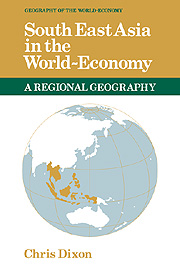Book contents
- Frontmatter
- Contents
- List of figures
- List of maps
- List of tables
- Acknowledgements
- Sources and place names
- List of abbreviations
- 1 Contemporary South East Asia in the world-economy
- 2 Pre-colonial South East Asia
- 3 Western penetration: from trade to colonial annexation
- 4 Uneven development: the establishment of capitalist production
- 5 Development strategies and the international economy
- 6 South East Asia in the late twentieth century: problems and perspectives
- Notes
- References
- Index
1 - Contemporary South East Asia in the world-economy
Published online by Cambridge University Press: 22 September 2009
- Frontmatter
- Contents
- List of figures
- List of maps
- List of tables
- Acknowledgements
- Sources and place names
- List of abbreviations
- 1 Contemporary South East Asia in the world-economy
- 2 Pre-colonial South East Asia
- 3 Western penetration: from trade to colonial annexation
- 4 Uneven development: the establishment of capitalist production
- 5 Development strategies and the international economy
- 6 South East Asia in the late twentieth century: problems and perspectives
- Notes
- References
- Index
Summary
Introduction
South East Asia has played a major role in the world-economy. It has supplied key raw materials, provided markets for developed world goods, received investment and, most recently, multinational manufacturing. To a degree these roles have been sequential, reflecting the evolution of imperialism, the progressive incorporation of the region into the world-economy and the accompanying development of capitalist relations of production.
Western recognition of South East Asia (map 1.1) as a distinct entity is comparatively recent. Until the 1940s a variety of terms were applied to these islands and peninsulas, for example, Further India, the Far Eastern Tropics and Indo-China. Thus, South East Asia was viewed as an eastward extension of India, a tropical appendage to the Far East or merely the area between India and China. These terms strongly reflect the imperial structures that had been established by the early 1900s, as indeed the adoption of the term South East Asia during the 1940s reflected a radically different situation.
The emergence of South East Asia as a major sub-division of the world economy can be discerned during the 1930s. This was principally the result of the weakening of the established imperial structures. In terms of British policy, events in East Asia and moves towards some form of independence for India shifted the focus of activity towards Burma and the Malay Peninsula. Additionally, from the mid-1920s South East Asia's resources and markets had become a focus of increasing rivalry between the USA and Japan.
- Type
- Chapter
- Information
- South East Asia in the World-Economy , pp. 1 - 34Publisher: Cambridge University PressPrint publication year: 1991



